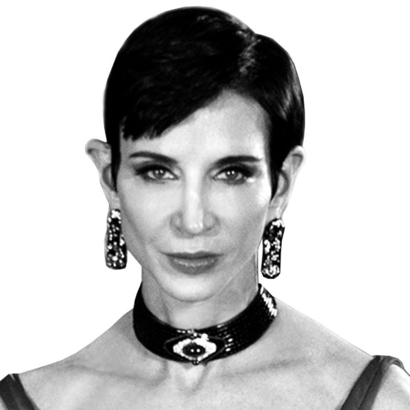On the eve of the opening of his retrospective, “Stephen Jones, Chapeaux d’Artiste,” at the Palais Galliera, in Paris’s Eighth Arrondissement, the famed British milliner is fitting a lacquered straw boater on the head of a friend. Because this natty number is by Jones, it bears only a passing resemblance to traditional headgear of its genre. Its scale is reduced, its color is oxblood, and its low crown looks like a lambchop, finished with a frill.
As the designer is pressed for time, he has made a corner of Les Lounges, on the ground floor of the princely Shangri-La hotel, into a posh makeshift atelier. Other hotel guests, scattered on tufted banquettes and silky divans, pause their conversations to watch a metamorphosis take place before their eyes. Jones nimbly tilts the hat a few degrees, rotates it into place, and walks his friend to the room’s mantel mirror. She has been transformed—her facial structure has sharpened, her irises have brightened, and her whole countenance has assumed an enigmatic allure. Acknowledging the effect of his handiwork, Jones says, “It’s magic.”

The following night, braving a downpour, around a thousand guests pass into the Galliera to view a show exceptional even for a city accustomed to fashion spectacles. A 129-year-old, government-funded museum, the Galliera has never devoted an exhibition to a living designer before and has not featured a milliner—much less a foreign one—as a subject since 1984.
“When the director suggested an exhibition to me eight years ago, I thought she was talking about one vitrine,” Jones says. Instead, the institution has dedicated a succession of salon-like galleries to approximately 200 of his confections, starting with his 1979 graduation piece from St. Martins, featuring a spiky, translucent plastic tiara and the feathers of a dead seagull.
“The most punk thing you could do at that moment was to try to be a hat designer,” Jones remarks. “No one in their right mind would consider such a thing. St. Martins hated that I was doing hats as it wasn’t part of the course.”
The Galliera has never devoted an exhibition to a living designer before and has not featured a milliner—much less a foreign one—as a subject since 1984.
Yet Jones quickly found a receptive audience “who believed in me more than I did” among the habitués of the über-cool underground club Blitz, the incubator of the New Romantic movement. Fellow Blitz kid (and Jones flatmate) Boy George cast him as a fez-wearing extra in the music video for Culture Club’s 1982 hit “Do You Really Want to Hurt Me?” Enraptured by this fez, Jean Paul Gaultier commissioned the young Brit to create an assortment of them to enliven his 1984 Autumn/Winter collection. Before long, Jones began collaborating with other French houses. “They welcomed me with open arms,” he says.
Azzedine Alaïa sent Jones to Thierry Mugler, for whom he created the flamboyant halo worn by a pregnant Pat Cleveland—as much of a showstopper at the Galliera today as it was 40 years ago on Mugler’s runway. Montana, Givenchy, Louis Vuitton, Schiaparelli, Dior, and other Paris-based brands all eventually followed suit, even as Jones produced his own independent seasonal collections (85 of them to date) back in London. Probably the hatter’s most familiar display in the sensational Dior section of the exhibition is the quivering, antenna-like ostrich-and-turkey-feather ornament that sprouted from Lady Gaga’s head when she performed at the 2024 Summer Olympics opening ceremony.

As the protean designer finds inspiration everywhere he looks, there is a glossy-red London-telephone-booth-inspired hat with a sex worker’s business card tucked into its band, a Place Vendôme cap, a trompe l’oeil bowl of onion soup, an oozing peanut-butter-and-jelly sheepskin sandwich, and, for Thom Browne, an architectural gargoyle mask. A lyrical tribute to model Stella Tennant incorporates the curling, yellowed pages of a Robert Burns poetry volume over which hovers a lark. Fully capable of going meta on himself, Jones has situated among his infinite variations on the top hat one example that replicates a giant spool of thread, jauntily lanced with a sewing needle.
But his simplest designs can sometimes be the most affecting, as certainly is the case with the snappy woolen beret he contrived for Princes Diana to complement a suit by Jaspar Conran (who introduced the two) in the early years of Jones’s career and of her marriage.

“Chapeaux d’Artiste” makes a very persuasive case for Jones’s conviction that simply “by wearing a hat, people are going to have a good time.” A hat, the audacious master milliner insists, is “a punctuation mark, a question, an exclamation—and a fabulous lie,” materialized from the “land of make-believe.”
Amy Fine Collins is an Editor at Large at AIR MAIL. She is the author of The International Best-Dressed List: The Official Story


